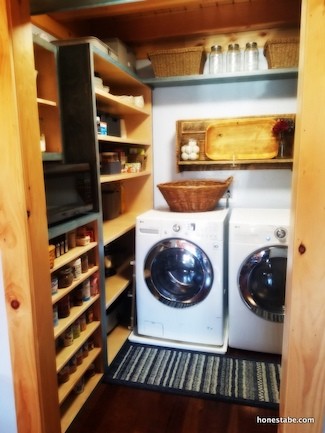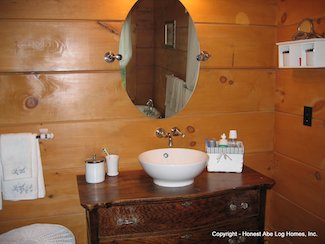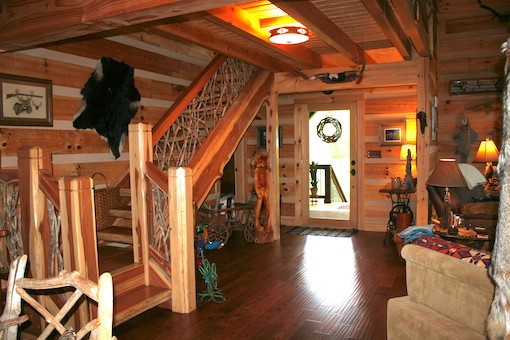The many television shows and podcasts that feature do-it-yourself home projects as well as the ever-growing Pinterest community demonstrates the intrigue of taking control of the design or redesign of personal living spaces. We asked Josh Beasely, President of Honest Abe Log Homes, about log and timber homeowners and whether the DIY craze is also invading this industry.
Why do you think people are intrigued by the idea of “doing it themselves” when it comes to log and timber homes?

The laundry room was not the only area of this new log home completed by the homeowners. After the Honest Abe delivery and dry-in, they finished the home themselves.
Fundamentally, I think it speaks to our desire for accomplishment. To stand back at the end of the day and be able to say, “I built that” or had a hand in the process is a proud moment. We create stories and legacy that can be shared down the road in a project like building our own home. I remember someone talking about the process once, and they went on and on about their kids helping out and how they still talk about it today.
What are some of the things people should keep in mind when considering building their log home on their own in terms of time, money, knowledge, etc?
Honest Abe was really established in a time where sweat equity was put into homes by owners building themselves. Unfortunately that is no longer the case, and it’s difficult to advise someone to build on their own. Certainly understanding the time that it takes is a major factor and time is money, but there are even more practical hurdles in the way. Financing a self-build project seems extremely difficult. Banks want to know their investment will be completed on time and to the quality standards necessary to recoup should the home end up back in their hands. Building codes are more universally enforced, the code itself has become much more complicated over the years, and code enforcement can often be subjective. Constructing a portion of a home that doesn’t meet code can become very costly to bring up to compliance. This is one of the areas where a good General Contractor earns their keep.
If the whole project is too big for a client to handle on his or her own, what are some smaller projects (or parts of the overall) they could take on themselves?
This approach is more feasible in today’s building environment. Light interior work like painting or staining are practical. If the owner has specific experience in other areas of building, then more opportunity may be available. I would highly recommend that clear and frequent communication be made with the General Contractor in this case. Making sure it’s understood when everyone’s responsibilities start and stop are important. Furthermore, be conscious that to the G.C. and their subcontractors that time is money as well. If an owner’s work holds up progress that isn’t accounted for, it could cause tension between the parties.
How can they best work in partnership with their log home builder if they do want to take on at least part of the home themselves?
This goes back to communication, and I would suggest again that it starts with the G.C. In the case of Honest Abe, we often do a portion of the construction called a dry-in within a certain radius of our office in Tennessee. We’ve had several instances where home owners have helped stack their log walls with the construction crews help and oversight. Again, this goes back to that feeling of accomplishment and creates a story that can be told for years to come. In the custom home featured at the top of this article, the homeowners opted to craft a stairwell from local cedar logs and created the stair rails from dried tree branches.
Do you have any clients who have done part of their house themselves? If so, tell me about the project and how it turned out.

These homeowners in Virginia acted as their own contractors, did much of the finish work themselves and added special touches like repurposing antiques for cabinetry.
Yes, and generally they have turned out well. In our history, we’ve had numerous clients do the complete construction, but that is a very rare instance now. More often we see clients choosing to only do some of the finish type work themselves. They’ll pick a room to finish, or maybe a specific portion of a project like laying the hardwood flooring.
Any other pros & cons?
My advice is to be honest with yourself when considering building or even completing small portions. If you want involvement, see if your contractor is open to having your help, volunteer to swing a hammer occasionally, help pack materials, clean up, pack and stack logs, etc. It’s possible to create a sense of accomplishment and pride without saddling yourself to a lot of responsibility.




